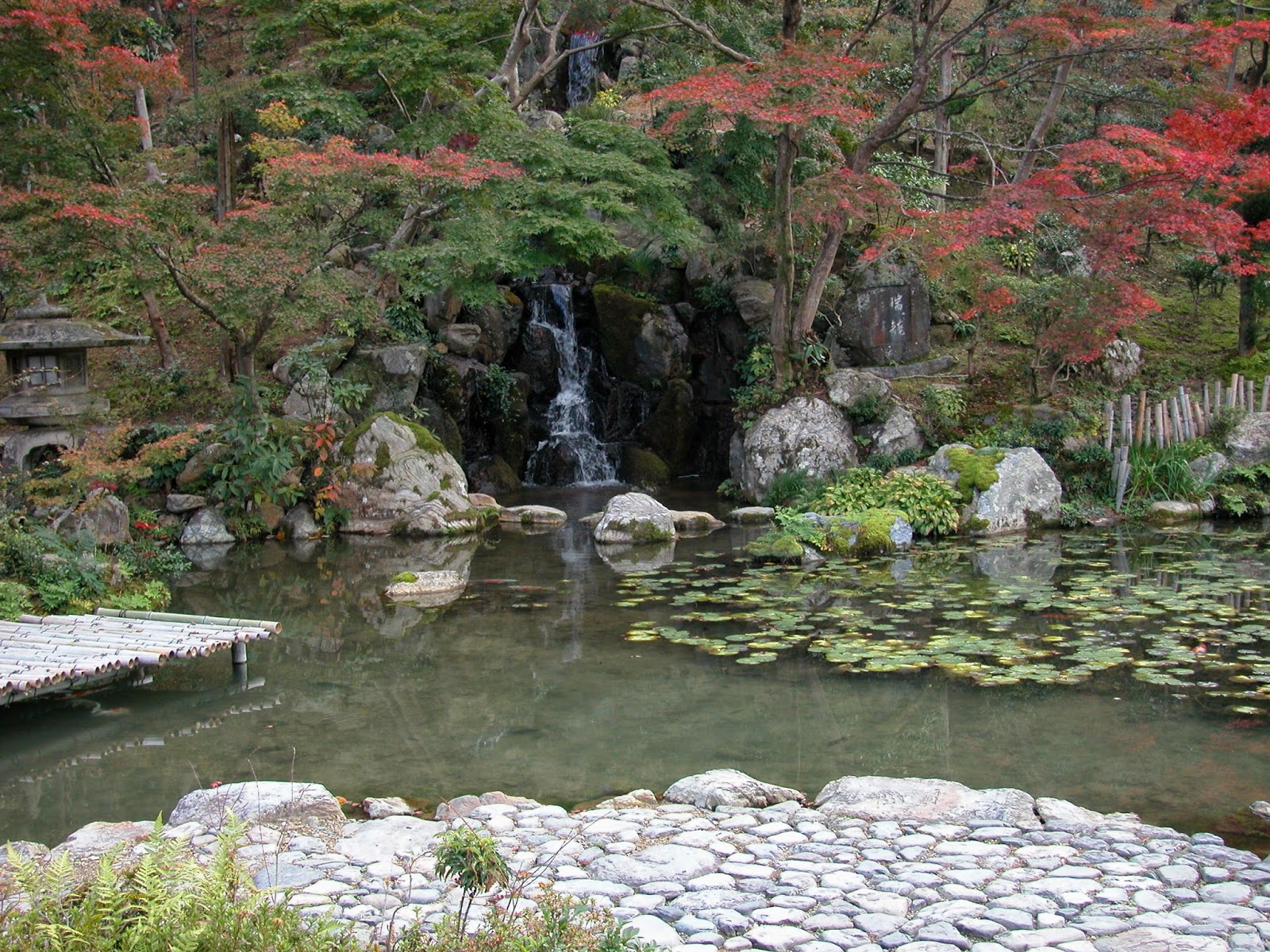Perhaps the most essential element of the Japanese garden
has no taste, nor scent, it cannot be heard nor seen; nor does it have any
distinctive form of its own. Yet when we study the form and the practice of the
Japanese garden creation it soon becomes apparent that energy (気力, ki in Japanese, qi in Chinese) is the ‘raw
material’ with which we communicate most directly with. Energy can be seen in
two distinct forms; direct energy and potential energy. Direct energy can be
observed in something that physically moves, in the garden we can experience
this in the form of a stream or a waterfall, or over a longer period of time in
the growth of a plant. Potential energy is perhaps more subtle, less obvious,
as it represents the potential for movement, or the implication of movement.
Something that is about to happen, something that is about to occur. This can
be seen in a pattern, also in forms themselves. Potential is something that the
eye/mind detects in a pattern or the manner in which form is organised, and
onto which it projects future time and change.
 |
| Daichi-ji |
One of the key design techniques in many Japanese arts is
the use of asymmetry (不均斉, fukinsei), and this is applicable to Japanese garden creation as
much as painting or ikebana (flower
arrangement). Symmetry implies that there is a balance in the distribution of
forces, what happens on the left side is equal to what happens on the right
side. But because the two sides are equal, the potential for change is limited
by the one side cancelling out the other. In the case of asymmetry there is
greater potential for change as the inequality of balance leads to the mind to
anticipate the flow or movement from one side towards the other. In the
oriental mode of thought, yin and yang are in a ceaseless state of
transformation from one into the other. In other words the process of life is
transformation and change, not stasis.
 |
| Kosho-ji |
In the
Japanese garden all the elements that go into the construction of the garden
are seen as being essentially patterns of energy, and the task of the garden
creator is to bring together those energies in a harmonious manner. Hence there
are no formulae to the creation of such gardens. The training of a gardener,
and the mark of a great gardener lies in the sensitivity to the use and
potential expressiveness of the materials themselves. What is their voice? What
is their song? In other words in the ability to understand, appreciate and use
the inherent energy of the elements that make up the garden. The garden creator
becomes a conductor, as well as composer.
 |
| Raked gravel, Zuiho-in |
Earth
geomancy, or feng shui in Chinese(風水) (Fūsui in Japanese) is a complex system of concepts that seeks to
understand the way natural phenomena operate. The interpretation of the results
can be used to guide the way humans interact with their environment. In Heian
period Japanese society (785-1184) geomancy was widely applied to the creation
of gardens, this was particularly the case in the siting of streams. In the Sakuteiki (Book of Garden Making) which
was complied around mid to late 11th century, instructions are given
for introducing streams in the north-easterly quadrant of the site, flowing
towards the south and then exiting via the south westerly quadrant. The
intention of this was that the stream would ‘cleanse’ the site of malevolent
energies. In the Sakuteiki a whole section is devoted to the subject of taboos.
Many of the taboos concern the placement of stones, a way of understanding the
role of taboos beyond mere repetition of superstition is to understand that the
‘incorrect’ placement of elements of the garden was deemed wrong because it
would interfere with a harmonious flow of energy through the site. Gardens were
seen as being capable of influencing the health and mental wellbeing, as well
as the spiritual wellbeing of the owner and visitors to the garden. This
concern still exists in Japan even if the understanding of such an application
of the garden has been diluted by a transference of the appreciation of the
garden to more aesthetic concerns.
 |
| Umekoji Koen |
What can be
applied broadly to the garden as a whole in energetic terms, can also be
applied to individual elements that make up the garden. Thus rocks, water
feature, plants, land forms and space itself, all can be interpreted as having
an energetic value and potential. The manner of combining garden elements can enhance
or diminish their potential effectiveness. We should perhaps not regard this as
being some obscure and entirely esoteric Oriental practice, as it has become
well accepted now that all things (animate and inanimate) have an
electromagnetic field that can be detected. In subtle ways we as visitors to a
garden are influenced by our emotional and incorporeal response to the
environment and landscapes in which we move. What we ‘see’ is partially
determined by what we ‘feel’, and mostly this interaction occurs outside of our
conscious analytic mind. In the great Japanese gardens this sensitivity is
expressed in a highly refined manner, and applied by a heightened intuitive
sense developed through practice and observation.
 |
| Kaiuso Sanso |
To follow this blog: the 'Follow by E-mail' facility is now operating. Don't miss a beat and sign in. If you enjoyed this, or any other post, please let me know! If there are specific aspects of the Japanese garden tradition you are interested in, please let me know. Thanks.
No comments:
Post a Comment